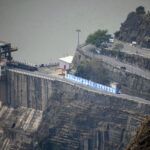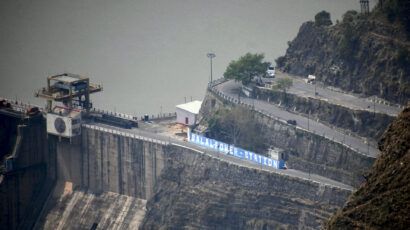The U.S. satellite shootdown: China’s response
By Eric Hagt | March 5, 2008
Despite characterizations in the Western media to the contrary, China’s official reaction to Washington’s intentional destruction of the errant USA-193 spy satellite–an action many have interpreted as an antisatellite (ASAT) test–has been fairly muted. Chinese Foreign Ministry Spokesman Liu Jianchao merely called for the United States to provide data on the test, and for Washington to live up to its international obligations–presumably a reference to the 1967 Outer Space Treaty and the 1972 Liability Convention. Liu’s call for information was mainly an attempt to ascertain the potential danger of debris from the shootdown to China’s territory, its orbiting assets, and space access. In short, Beijing asked for data, not an apology or explanation. Yet, Liu also expressed concern over the shootdown’s impact on space security, seemingly anxious that it could potentially provoke an arms race in space.
Certainly, there’s a degree of hypocrisy in China’s demands considering the nature of its January 2007 ASAT test. But that doesn’t mean Beijing’s concerns about a space arms race are unjustified. While not an official part of the message, the national anxiety about this possible development has manifested itself in a lively discourse among scholars, analysts, and defense blogs. (See “Yadong Military,”“Tiexu,” “Xilu,” military.china.com, and “Idoshequ,” all of which are in Chinese.)
First, there’s near unanimous disbelief at the official U.S. explanation for the shootdown. “This is all about trying to reduce the danger to human beings,” U.S. STRATCOM Commander James Cartwright declared, referring to the health risk that would have supposedly resulted from human exposure to hydrazine fuel contained within the satellite. But only three percent of respondents to a Sing Tao Daily survey [in Chinese] accepted this rationale.
They were right to question Washington’s public reasoning. Realistic estimates put the chance of a casualty from exposure to the toxic fuel at no more than 1-3 percent. (See “A Preliminary Analysis of the Proposed USA-193 Shootdown”.) But this figure doesn’t account for the near impossibility that the hydrazine tank would survive the 50 g-forces acting on it during reentry, putting the probability of killing someone on Earth below 0.01 percent–NASA’s baseline standard.
In the absence of a credible rationale, suspicions of ulterior motives abound. Mainly, many believe that the shootdown was a disguised demonstration of the U.S. missile defense system’s ASAT capability. (See “Interview with Pang Zhihao,” Chinese Academy of Space Technology researcher and vice chief editor of Space International [in Chinese] and “Chinese Military Affairs Experts Expound on the Downing of Uncontrolled U.S. Satellite” [in Chinese].) The talk of one-off software modifications that “would not be transferable to fleet configuration” provides little comfort since, once done, software uploads prove the capability and can be downloaded in the future to missile defense platforms.
After the shootdown, Defense Secretary Robert Gates made the cryptic remark, “[T]he question of whether this capability works has been settled, [rather] the question is against what kind of threat, how large a threat, and how sophisticated a threat.” He was referring to the shootdown as proof that the missile defense system is successful and not a waste of money, while presumably, trying to assure China that the incident wasn’t intended to demonstrate a capability to negate Beijing’s strategic missile force.
But interpretation of the event disproves this reasoning. The shootdown didn’t answer the biggest question about the system’s effectiveness–the ability to circumvent a warhead’s countermeasures (See “No, It Doesn’t Prove That Missile Defense Works.”) In addition, China does suspect the system is useful against missiles, and more importantly, its satellites; softer targets with predictable orbits and no countermeasures (See “China’s Military Experts Analyze U.S. Plan to Down the Uncontrolled Satellite” [in Chinese].)
While the USA-193 satellite was intercepted at an altitude of approximately 130 miles, the range of the SM-3 Aegis enabled platform that downed it can potentially hit targets at least 300 miles high. That’s the lower end of low Earth orbit, but satellites do pass through that altitude. 1 Furthermore, upgrades and next generation systems will increase the interceptor’s speed, allowing it to reach satellites throughout low Earth orbit up to 1,200 miles.
With the credibility of the Pentagon’s explanation for the shootdown in doubt, Washington’s contention that this action was fundamentally different from the Chinese test loses persuasiveness. China’s incident certainly created far more, longer-lasting space debris. (See “Analysis of the 2007 Chinese ASAT Test and the Impact of Its Debris on the Space Environment” and “Space Debris from Antisatellite Weapons.”) But U.S. characterizations that its action was more transparent than Beijing’s test are false. As one Chinese blogger asked, “What’s the point of transparency when the justification given doesn’t hold up?”
A proven ASAT capability of the Aegis system is particularly unsettling for China. (See “U.S. ‘Ulterior Motives’ in Destroying Satellite With Missile” [in Chinese].) As a mobile, sea-based platform, this capability can be moved throughout much of the globe, giving the United States almost worldwide coverage, while China’s single ASAT test gives Beijing an incipient land-based ASAT system limited by its ability to only hit enemy satellites passing within range and China’s missile launch infrastructure. (See “How China Loses the Coming Space War.”) Furthermore, land-based launchers are far easier targets than sea-based launchers. Chinese commentators also stress that the Aegis system is an “active-duty system,” making it a “combat ready” platform–a far more advanced capability than China possesses.
But more disconcerting for Beijing is that Washington plans to sell the Aegis platform. Japan, who is codeveloping the system with the United States, is the main customer–for now, as the United States plans to sell it to other Asian countries, including South Korea, under the Foreign Military Sales Program. The most recent test of the Aegis ballistic missile defense system was executed using a Japanese destroyer. Japan’s ever-strengthening alliance with the United States makes for a strategically threatening environment for Beijing, especially given China and Japan’s chronically volatile relationship. Furthermore, the real possibility of Japan using a coordinated Aegis missile defense system during a conflict over Taiwan is a nightmare scenario for Chinese military planners. Some in China have linked the shootdown to Taiwan more directly, suggesting that it must be a warning considering its timing–a month prior to the Taiwanese presidential election. (See “U.S. Shooting of Its Satellite: Deliberate Action.”)
Lastly, the shootdown comes amidst renewed U.S. opposition to any space arms control treaty fostered at the Conference on Disarmament (CD). Despite its ASAT test, China has continued to champion a treaty banning space weapons since 1984. U.S. behavior is potentially more insidious because it legitimizes testing; the argument being that such tests are okay as long as they don’t create persistent space debris. As a result, Washington has effectively ceded the moral high ground in space and criticism of comparable tests in the future will be hypocritical. In fact, the Russians and Indians just might follow suit.
How will all of this affect China’s actions? The answer is mixed. Like the United States, some in China support developing military space assets to safeguard national security interests. (See my Winter 2007 China Security article, “China ASAT Test: Strategic Response”.) And regardless of U.S. guarantees to the contrary, the downing of USA-193 is being perceived in China as a riposte to Beijing’s ASAT test. As such, the U.S. shootdown will increase the incentives (and internal pressure) to stimulate China’s ASAT program. 2 Already, there have been increased signs that Beijing intends to develop its own missile defense system. (See “China’s Missile Defense State of Affairs” [in Chinese].) The dual anti-missile/ASAT capability of such a system, explicitly demonstrated by the U.S. shootdown, makes this an especially attractive option.
That said, as in the United States, there are strong diplomatic and institutional constituencies in China with a deep interest in averting a renewed military space race. Evidenced by its commercial and civilian programs, China clearly has huge ambitions in space, which a military competition would jeopardize. (See “Mutually Assured Vulnerabilities in Space”.) And considering China’s stance at the CD to negotiate a ban on space weapons, its repeated chirping that a military space race is unaffordable, and that any such competition will harm Beijing’s larger strategic relationship with Washington, there are powerful drivers against China developing ASAT weapons.
A regime to control and/or ban weapons in space would certainly buoy the voices against ASAT weaponry. But of course, many experts are critical of arms control measures. Some of their criticisms are valid, but they lose sight of the fact that weaponizing space is ultimately in the worst interest of any country. Unlike other military assets, the predictable and vulnerable orbits of space assets makes defending them far more difficult than attacking them. In addition, the debris caused by testing space weapons would render space unusable for everyone, making an all-out space war completely infeasible. Moreover, the United States has the most to lose in a space war with more than one-half of the world’s 800 satellites serving Washington’s commercial, civilian, and military interests. Given this reality, it’s wrong to glibly dismiss China’s sincerity to attain a ban on space weapons or Washington’s national interest to pursue it.
A treaty that would outlaw space weapons is possible. (See “Space Wars, Coming to A Sky Near You.”) Due to the opacity of all national space programs and the dual-use nature of space technology, assuring compliance is complex. However, full verification might not be necessary. Effective treaties already exist that don’t require intrusive verification–i.e., the Biological Weapons Convention. And because Earth-bound observers can readily detect unreported launches and orbital debris, the testing and use of ASAT systems and ground-based and space-based destructive weapons would be easily verifiable.
Yet, an arms control treaty is unlikely, not from a lack of strategic necessity, but from a lack of political courage. It would require the United States and China to come clean about their space ambitions and transcend the zero-sum dynamic of space security. And judging from China’s response to the U.S. satellite shootdown, this will not likely happen any time soon.
1E-mail exchange with David Wright (Union of Concerned Scientists), see also the Center for Defense Information website.
2E-mail exchange with Chinese scholars.
Together, we make the world safer.
The Bulletin elevates expert voices above the noise. But as an independent nonprofit organization, our operations depend on the support of readers like you. Help us continue to deliver quality journalism that holds leaders accountable. Your support of our work at any level is important. In return, we promise our coverage will be understandable, influential, vigilant, solution-oriented, and fair-minded. Together we can make a difference.
Topics: Nuclear Weapons, Opinion















